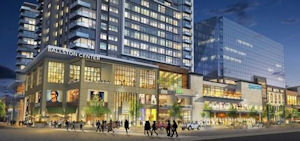 I pilloried Arlington County in a previous post for building $1 million bus stops. Now for a reminder of what the county is doing right… Forest City Washington, reports the Washington Post, is planning an upgrade of Ballston Common Mall that would add a row of sidewalk retail along Wilson Boulevard and build 306 residential units above the property.
I pilloried Arlington County in a previous post for building $1 million bus stops. Now for a reminder of what the county is doing right… Forest City Washington, reports the Washington Post, is planning an upgrade of Ballston Common Mall that would add a row of sidewalk retail along Wilson Boulevard and build 306 residential units above the property.
The 578,000-square-foot mall has four levels at present. Adding the residential units will entail a significant increase in density, and Forest City will have to get a number of approvals from Arlington County.
County planner director Robert J. Duffy is receptive to the concept. “The county would like to “see the mall become a much more open and attractive mixed-use project. … We need to encourage … a vibrant place-making development that has a strong and active presence on the street.”
Arlington County is not afraid of density. Its planning officials know how to make density work. Focus on the phrase “place-making.” If past is prelude, Arlington’s planners will work with Forest City to make that the re-developed mall improves the surrounding urban fabric, not detract from it. They also will extract proffers (or other financial concessions) from Forest City to help pay for infrastructure improvements made necessary by the project — but they will provide enough added density and leave enough money on the table to make it a win-win.
Bacon’s bottom line: The project will make fiscal sense because Ballston Common is located only two blocks from the Ballston Metro station. The transportation infrastructure is already in place. Indeed, apartment dwellers will generate more fare revenue for the rail and bus services. The utilities are in place, too. The water-sewer pipes will be vertical (running up the high-rise, thus paid for by the developer) not horizontal (running through a green-field tract). Fire, police and rescue are all there. No need to build new stations or augment staff.
That’s what you get when you’ve spent the past 40 years building cost-efficient human settlement patterns.
There is one potential fly in the ointment. Depending upon the demographics, adding 360 residential units could add a couple hundred kids to the county school system. On the plus side, if neighboring schools haven’t maxed out their capacity, perhaps they can absorb the kids without the need to add new buildings. On the other, Arlington County spends a lot of money per child. I would like to know how county planners factor that into their thinking.
— JAB


